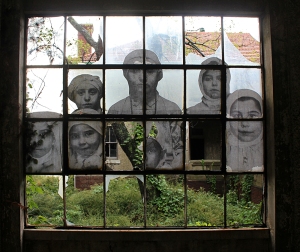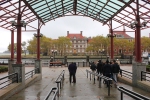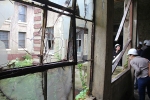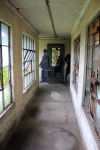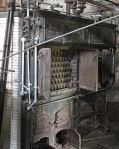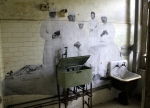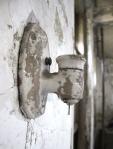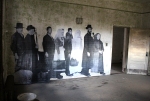My first memory of September 11, 2001, is pulling out of the ground floor parking lot of our apartment on Avenue C and 15th Street in lower Manhattan, about 9 a.m.
My wife owned a knitting store and had just walked across the street to catch a taxi uptown and as I pulled out of the garage, headed across Manhattan for MSNBC.com’s offices in Secaucus, N.J., I flipped on the radio to get a traffic report.
The WCBS Radio traffic reporter, in a helicopter over Manhattan, was reporting a strange occurrence. It appeared that a small plane had crashed into the World Trade Center, he was reporting, which made no sense since it was a perfectly clear, cool September morning. Maybe the pilot had a heart attack, he surmised.
I was a writer for the special projects unit at MSNBC.com at the time and decided that since this would be a fairly important story, I should head downtown and try to interview people at the scene, so I circled back into the garage and headed upstairs to our third-floor apartment, to grab my video camera. As I walked in, I turned on the TV, just in time to see the second plane strike the South Tower.
Suddenly the “small plane crash” turned into a terrorist attack, and I decided I should head in to the office ASAP. Besides, my camera battery was dead.
As I headed across town, I could see crowds on every street corner, all looking downtown, where the smoking Twin Towers were visible in the distance, down Manhattan’s long North-South avenues. I was only halfway across the island, however, when I realized my idea of heading through the Lincoln Tunnel to work might not be smart. The tunnel had been mentioned as a possible terrorist target and if there was ever a morning when that was not just a paranoid thought, this was it. Besides, odds were that the New York police department would close the tunnel anyway. So I decided to go back to my original plan and head downtown, to interview people about the terrorist attack.
Sept. 11 was municipal election day in NYC, with Mike Bloomberg the favored candidate to replace Rudy Giuliani as mayor, so I thought people coming out of a polling place would be good to interview, as in “people voting in a democracy on the morning of a terror attack,” and I found a few folks willing to talk.
I still have my notebook from that day. But my scribbled handwriting is almost illegible, belying my outward calm.As I headed farther south, a crowd gathered at an intersection caught my attention. They were pointing to the burning WTC and I heard someone say “they just jumped.” As I joined the group, the horror of what they were watching was too clearly visible. At intervals of a few seconds, bodies were dropping from the top of the Twin Towers and the enormity of what was happening became more evident. But what my eyes were seeing was difficult to process. I’d been a reporter for 30 years, but most of that time, I’d covered staged events – press conferences, elections, city council meetings. I’d written about crimes, but I got my information from a police report, not from standing nearby and watching them unfold. I had never watched while people died, in horrendous circumstances.
The South Tower was the second to be hit, but the first to collapse, to the east. From where I stood, 8-10 blocks away, it was unclear in the smoke whether all or only part of the building had collapsed. I don’t remember thinking consciously that there were hundreds of people inside. At the time, what was happening was too incomprehensible for those thoughts.
A few minutes later, two U.S. Air Force fighter planes roared overhead, circling the smoking towers, too late to do anything. At that moment the thought of Pearl Harbor entered my mind — this must be how it felt that morning in Hawaii. I kept walking south and about 6-8 blocks north of the towers, I saw a man, maybe in his mid-30s, headed my way, covered in dust. By that time, I was in a small group of 6-8 photographers, some perhaps freelancers, others maybe working for local media, a ragtag group. I didn’t have an NYPD press pass – didn’t need one since I never reported from NYC – but I had a couple of MSNBC.com IDs on a chain around my neck, so the man stopped when I asked him a question. He’d been in the North Tower, the first one hit, and had fortunately decided to get out of the building after it was struck. He had made it outside and far enough away not to be killed when the South Tower collapsed, but close enough to be covered in dust. Soon there were dozens more, all headed north or east or west, away from the wreckage of the WTC.
Our motley group had made it to the vicinity of Duane Street, perhaps 1,500 feet from the towers, when an NYPD van pulled up in front of us and a group of officers got out and blocked the street, telling us we could go no farther and perhaps saving our lives. I’ve tried to calculate how long it was between that moment and when the North Tower fell and I have no sense of the time. Perhaps two minutes, perhaps four. Enough time for us to get closer to the towers, and once we got close, we wouldn’t have stopped until we were directly at the scene. I’ve wondered what would have happened, what the sound would have been like, whether I would have reacted in time and run in the right direction, whether I would have been killed by falling debris or suffocated by the dust.
Instead, I was staring at the smoking North Tower when the top seemed to explode. The lower floors had collapsed and as they did so, all of the windows in the floors above them shattered into a mist of glass. The exterior columns began to slowly arch backward, in slow motion, as the tower collapsed. The police officers yelled at us to find shelter and I ran toward the lobby of a nearby small hotel.
Within seconds, the air outside filled with dust and debris, turning first gray and then black.
Inside the small lobby was one police officer, 3-4 Fillipino hotel staff members, the hotel manager, a young homeless man from a nearby shelter, and two Dutch tourists, who had come downstairs with their luggage, headed for the airport, not knowing yet that their flight would be cancelled.
I asked the manager for permission to use his phone to call my office and dictate a few paragraphs to my editor, describing the North Tower’s collapse, as the police officer began to explain how we should all get a towel to cover our faces and we would try to find a way out the back of the hotel, where perhaps the dust cloud would be diminished. The young man began to moan and wail.
But the darkness outside the hotel door began to lighten, first to gray, then to white and finally the blue sky was visible.
I stepped outside to an altered landscape, covered with a white layer of dust and thousands of pieces of paper, blown from the WTC offices.
I decided to head west, parallel to the WTC site and almost immediately encountered two U.S. Customs Service employees, who had fled their offices in the WTC but now had no idea what to do. Their office was gone, the fate of their fellow employees unknown.
I walked away and continued to the Westside Highway on the Hudson River, near Stuyvesant High School. A group of firefighters were sitting on the curb, covered in dust, obviously weary. I asked one them, with a streak of blood curling down his forehead, what had happened to them. They had been trapped in a corner of the collapsed South Tower, he said, but they had found their way out and now were going to head back to try to rescue other colleagues who might be in a similar situation.
A group of 5-6 men who appeared to be in their 50s and 60s, all dressed in a uniform of white shirts and black pants, were huddled in the middle of the highway. I guessed they were top New York Fire Department officials and edged closer, to hear what they were saying. One of them stepped aside to talk to me and he explained that they were having trouble communicating with their firefighters. He told me that there were at least 300 of them in the two towers that had collapsed and were feared dead. But a colleague saw him talking to me and shooed me away, saying “get the press out of here.”
I was perhaps the first reporter to learn that 300 New York firefighters had died that day, by far the worst casualties in the fire department’s history, but I never reported it. I didn’t know the name or rank of the officer who answered my questions and didn’t even know for certain that they were fire officials, although with hindsight I’m certain that was the case.
But it didn’t matter. There were no iPhones in 2001 and cell service in New York City was unusable as was most phone service. I realized later I could probably have borrowed a land line from a business somewhere, as I did at the hotel, and contact my office.
But at some point, the enormity of the event just overwhelmed my instincts as a reporter.I walked back toward our apartment in Stuyvesant Town, thinking when I got there, I could try to contact the office using my laptop.
On the way, a cluster of people were gathered around a taxi driver who had his radio turned up loud, and the announcer was explaining that another plane had crashed into the Pentagon.
With cell service unavailable, there were long lines at pay phones (yes, they still had them in NYC in 2001) which were apparently working.
At one point, I encountered several reporters interviewing an elderly man, who explained that he had been the janitor at a building near the WTC, and that an engine from one of the planes had crashed into the roof of his building.
On nearby streets as I headed back north and west, dozens of people were walking, headed home across the Brooklyn Bridge or further north in Manhattan. A bus passed at one point, with the driver on a loudspeaker offering rides to the Javits Center for those who needed help getting uptown.
I tried to call my wife when I reached our apartment, but the phone lines were not working, overwhelmed by traffic. She spent an anxious 5-6 hours at a friend’s apartment before she reached me and realized I was OK.
I typed up my notes and eventually managed to send them to our HQ in Redmond, and for a few minutes they were published on the site, unedited, although I had intended them only as notes and not as a story. They were quickly replaced as more and more reports came in about the terror attack and our main story kept getting rewritten and updated.
My main memory of that afternoon is of sitting on our sofa, staring into space.
The television kept showing images of the smoking ruins, but nothing had changed, really, since 10 a.m. that morning. There were no dramatic rescues, no survivors, no perpetrators arrested or sought.
What I remember most about the following days was the smell, of concrete and smoke, that hung in the air over all of Manhattan below 23d Street.
The boots I was wearing that day were covered in dust. I still wear them on occasion.
But I have never polished them, because that would mean removing the dust.










